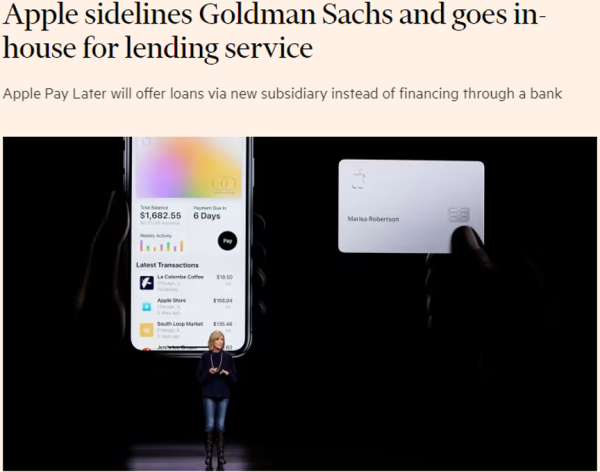If you would like to receive weekly updates like this, sign up here.
‘I think it will happen slowly, and then it will happen fast.’
That might sound like famous last words before jumping into the latest and greatest roller coaster ride out there.
But it’s much more prosaic than that.
It’s a comment related to banking.
I read it in a recent article, ascribed to James Cameron (no, not THAT one) a partner in AirTree Ventures, which has invested in the Australian neo-bank Athena.
Cameron’s quote concerned the digital disruptions across the mortgage market.
The contention is the more established banks will take their time to convert to a more digital based mortgage application process before it suddenly goes exponential.
However, it will be nimble digital based neo-banks that will take these developments mainstream rather than the more traditional and entrenched big banks of today.
We need to look deeper into this trend today.
Because something else is happening here, right in front of you. Not that it’s really reported right now.
I believe I’ve identified a true opportunity here.
You want to get on early here that’s for sure.
Take a look.
This is what Afterpay and Apple “really” want from you.
It comes down to simple demographics.
A whole cohort of potential new mortgage holders are coming into view. You might know them as Generation Y.
A generation that has spent most of their lives online.
Not only their streaming services for entertainment or using Uber Eats for their food consumption.
But using their personal digital wallets to pay for it all.
It makes total sense.
This is a fully digitally fluent customer base we are talking about here.
Take the view of Anthony Lieu, an online marketing officer for a law firm:
“I work at an online law firm, so I’m pretty comfortable dealing with service providers online,” he says. “I think fintechs are more focused on the client experience. They’re a bit more agile and responsive to the needs of what clients are looking for, and now they’re targeting a market where people are a bit more savvy online.”
Basically, if you want to appeal to people like Anthony you need to offer him a service that’s fast, time effective and mobile based.
In Australia, one of the largest providers of digital wallets is a company named Afterpay. They basically pioneered the mass adoption of the ‘Buy now-pay later’ (BNPL) model in Australia. In the US you’d find many people using Apple’s digital wallet.
Straight away, when it comes to delivering instant access to cash, Generation Y prefer fintech rather than the older more established banks.
This is an area where Afterpay was considered a market leader in Australia. In effect a digital pay-day lender that replaced traditional debit cards at checkout and allowed a small period where no interest was charged on purchases.
Instead, the cost to transact was placed on the retailor for the benefit of having a large group of Afterpay customers prefer to use you for their purchases.
So overwhelming was the take up that this model spawned dozens of competitors. And entrenched the usefulness of mobile based digital wallets in the process.
Here however is where things get quite interesting.
Put aside the convenience for one second: what else have customers of Afterpay and Apple handed over to them unwittingly?
A treasure drove of financial data on themselves. And data can be very lucrative.
Particularly once you realize that both these companies are now branching out into online digital mortgages.
It has already started.
How fintech will power the real estate cycle
Afterpay plans to start selling mortgages in 2022 through its recently launched banking app that is targeted at Gen Y women (those born between 1981 and 1996) and Gen Z (those born from 1997). Afterpay’s mortgages will be funded by Westpac, but even so, it shows the potential of fintech apps to move into the banks’ core territory.
How interesting. Do you think those customers are just arbitrarily chosen?
Of course not! This is the power of all that meta data on Afterpay’s customers, their spending habits, their likely income range and age profile.
Their aim is to corner the side of the market that is either just started or about to start buying their first home. By using Westpac as the underlying lender Afterpay can charge referral fees as they have done most of the hard work on Westpac’s behalf.
This will prove a very lucrative market. Competitors are already jostling for market share.
Up, a youth-focused neo bank bought by Bendigo and Adelaide Bank in 2021, also plans to start selling home loans through its app in early 2022. Up was launched in 2018 to provide digital accounts – and in November it said it had 40,000 customers saving for a home loan.
Again, look how these fintechs use their customers data to identify future opportunities.
Right now, the market here is small, estimated at around 3-5% of all new mortgages.
But in the US, this same portion is over 30%, and it is rising. This very fact is attracting the godfathers of the tech world: companies like Apple and Google.
Imagine what these two could do in terms of their customer reach and especially customer data should they go all in on mortgage financing.
 Source – Financial Times
Source – Financial Times
Imagine no longer. Apple is now offering loans directly to its customers via its first BNPL product.
In fact, they are swimming in so much money that Goldman Sachs has been politely sidelined as their preferred provider of credit.
This is the Afterpay model but on a scale that simply dwarfs it.
And once Apple has that data it needs, say hello to Apple mortgages!
Folks, this is coming. Don’t deny or put your head in the sand if you’re a traditional shareholder of a bank like Goldman Sachs, Barclays or the Commonwealth Bank of Australia.
If you are then you’ll likely be facing many years of underperforming earnings. You might be better off buying Apple.
Let me spell this out.
An entire generation of mostly first-time home buyers having access to home loans that can be applied for and granted within minutes. This is part of the present, more speculative, half of the 18.6-year Real Estate Cycle.
And people are just worrying about recession!
You need to ready yourself and your family for what’s to come – today. Do not be late on this particular trend.
Understand how the economy works, the timing of the second half of the real estate cycle and how to uncover the real opportunities before they become apparent.
This is how to start: with a membership to the Boom Bust Bulletin (BBB).
It will teach you the history of the 18.6-year Real Estate Cycle, why it continues to repeat to this very day and guide you to the opportunities that the cycle presents as it turns.
Right now, the set-up is in. Companies like Apple will not squander this type of market cornering opportunity.
Pretty soon some of the biggest and most powerful US banks, like Goldman Sachs, will be on the outside looking in. These banks will fight to get themselves into Apple’s new mortgage products as a preferred credit provider.
The history of the real estate cycle shows us when the credit spigots are fully open.
Apple moving into mortgages is the how.
The setup is in.
Do not miss this.
Best wishes,

Darren J Wilson
and your Property Sharemarket Economics Team
P.S. – If you would like to receive weekly updates like this, sign up here.
P.P.S – Find us on Twitter here and go to our Facebook page here.
This content is not personal or general advice. If you are in doubt as to how to apply or even should be applying the content in this document to your own personal situation, we recommend you seek professional financial advice. Feel free to forward this email to any other person whom you think should read it.



